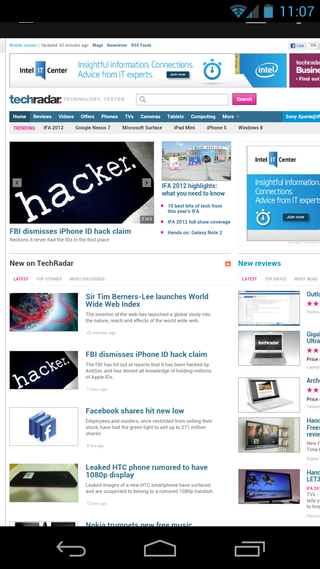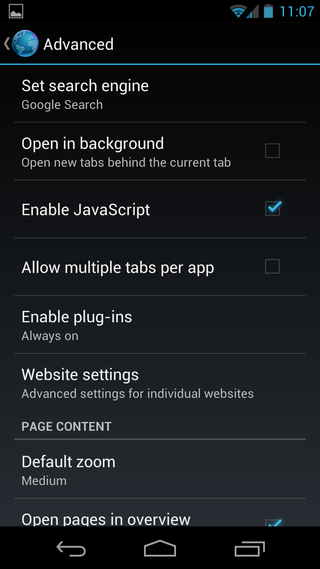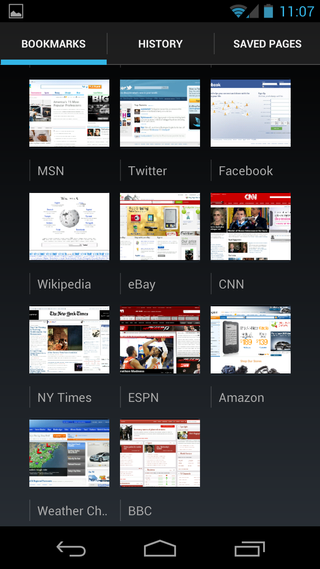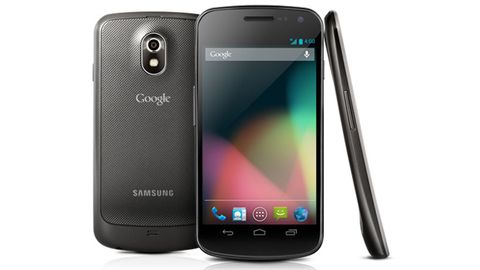Why you can trust TechRadar
The upgrade to Android 4.1 brings a big change to internet use on the Samsung Galaxy Nexus, and it's not a good one. What we're referring to is Flash, or rather its absence.
When the Samsung Galaxy Nexus launched with Android 4.0 there wasn't any Flash support either, but it wasn't long before the Flash Player app was updated to be compatible.
This time it's gone for good. Adobe have announced that they're ceasing mobile development of Flash Player and any device running Android 4.1 or above will be incompatible.

It's not the end of the world, Apple users have got on just fine without it. But much of the internet still uses it, so it is notable for its absence, particularly if you're coming from a device that does have Flash support.
Having said that, Flash aside, the browsing experience on the Galaxy Nexus is what you would expect. It's brilliant. Pages load incredibly fast over Wi-Fi and very fast over HSDPA.
We navigated to the TechRadar site and it took just three seconds to give us a full overview of the desktop version of the page. It was five seconds before the loading bar disappeared but the last two seconds didn't stop us from exploring or moving on.
Loading a mobile version of the site took less than two seconds. Doing the same test over 3G added roughly an extra two seconds, which is still pretty impressive.

We'd somewhat expected Chrome to become the default browser with the update to Android 4.1. After all, it's out of Beta now and is the default browser on the Jelly Bean rocking Google Nexus 7, but for whatever reason the Samsung Galaxy Nexus has stuck with the standard Android browser.
Pages are initially displayed full screen zoomed out and you can even choose a default zoom level from the menu to personalise this. Tap to zoom works well as does pinching to enlarge or shrink pages. Text reflows well on sites that our other Samsung, the Galaxy S2, failed to alter.
You can also save pages for offline viewing later which negates the need for the likes of Instapaper or Read-It-Later.
What Android appears to do here is store a large picture of the page you have saved because when we then put our Galaxy Nexus into offline mode and tried to click on links to see what it would say, we realised that links were no longer links but just text and touching it doesn't allow you to click on it, or even highlight it for copying and pasting.

Bookmarks are displayed through a tab at the top and can be added easily. You can also view several open windows, which are displayed in a card-style – the same as the one we get in the multi-tasking menu.
The browser is fantastic and aside from the lack of Flash, we had no complaints. However, we appreciate that Android's browser is not necessarily to everybody's taste and if this is the case, you can easily download a third party one from the Market.
There are dozens available with Google's Chrome browser being an obvious choice and the likes of Dolphin HD and Firefox being very credible alternatives.
Whichever browser you choose the great screen quality really helps here, making even zoomed out text impressively crisp, clear and readable.
James is a freelance phones, tablets and wearables writer and sub-editor at TechRadar. He has a love for everything ‘smart’, from watches to lights, and can often be found arguing with AI assistants or drowning in the latest apps. James also contributes to 3G.co.uk, 4G.co.uk and 5G.co.uk and has written for T3, Digital Camera World, Clarity Media and others, with work on the web, in print and on TV.


